I suggest scikit-image, skimage.draw.polygon() returns coordinates in the polygon. Here is an example. Create some random polygon data first:
import pylab as pl
from random import randint
import numpy as np
from skimage import draw
W, H = 800, 600
def make_poly(x0, y0, r, n):
a = np.linspace(0, np.pi*2, n, endpoint=False)
x = x0 + r * np.cos(a)
y = y0 + r * np.sin(a)
return y, x
count_buf = np.zeros((H, W))
sum_buf = np.zeros((H, W))
N = 2000
polys = []
for i in range(N):
x0, y0, r, n = randint(10, W-10), randint(10, H-10), randint(10, 50), randint(3, 10)
polys.append((make_poly(x0, y0, r, n), randint(1, 10)))
Then draw the polygons:
for (y, x), v in polys:
rr, cc = draw.polygon(y, x, (H, W))
count_buf[rr, cc] += 1
sum_buf[rr, cc] += v
mean_buf = np.zeros_like(sum_buf)
mask = count_buf > 0
mean_buf[mask] = sum_buf[mask] / count_buf[mask]
the time is about 1.5s on my pc to draw 2000 polygons with average radius 30 px.
Here is the result:

If you need better speed, you can copy the following code in scikit-image:
https://github.com/scikit-image/scikit-image/blob/master/skimage/draw/_draw.pyx#L189
https://github.com/scikit-image/scikit-image/blob/master/skimage/_shared/geometry.pyx#L7
and change the count_buf and sum_buf in the for loop if point_in_polygon() returns True.
Edit
Here is the Cython code:
%%cython
#cython: cdivision=True
#cython: boundscheck=False
#cython: wraparound=False
import numpy as np
cimport numpy as np
from libc.math cimport ceil
cdef unsigned char point_in_polygon(double[::1] xp, double[::1] yp,
double x, double y):
cdef Py_ssize_t i
cdef unsigned char c = 0
cdef Py_ssize_t j = xp.shape[0] - 1
for i in range(xp.shape[0]):
if (
(((yp[i] <= y) and (y < yp[j])) or
((yp[j] <= y) and (y < yp[i])))
and (x < (xp[j] - xp[i]) * (y - yp[i]) / (yp[j] - yp[i]) + xp[i])
):
c = not c
j = i
return c
cdef class PolygonAccumulator:
cdef int width, height
cdef int[:, ::1] count_buf
cdef double[:, ::1] sum_buf
def __cinit__(self, width, height):
self.width = width
self.height = height
shape = (height, width)
self.count_buf = np.zeros(shape, dtype=int)
self.sum_buf = np.zeros(shape, dtype=float)
def reset(self):
self.count_buf[:, :] = 0
self.sum_buf[:, :] = 0
def add_polygon(self, ya, xa, double value):
cdef Py_ssize_t minr = int(max(0, np.min(ya)))
cdef Py_ssize_t maxr = int(ceil(np.max(ya)))
cdef Py_ssize_t minc = int(max(0, np.min(xa)))
cdef Py_ssize_t maxc = int(ceil(np.max(xa)))
cdef double[::1] x = xa
cdef double[::1] y = ya
cdef Py_ssize_t r, c
maxr = min(self.height - 1, maxr)
maxc = min(self.width - 1, maxc)
for r in range(minr, maxr+1):
for c in range(minc, maxc+1):
if point_in_polygon(x, y, c, r):
self.count_buf[r, c] += 1
self.sum_buf[r, c] += value
def mean(self):
count_buf = self.count_buf.base
sum_buf = self.sum_buf.base
mean_buf = np.zeros_like(sum_buf)
mask = count_buf > 0
mean_buf[mask] = sum_buf[mask] / count_buf[mask]
return mean_buf
To draw the polygons:
pa = PolygonAccumulator(800, 600)
for (y, x), value in polys:
pa.add_polygon(y, x, value)
pl.imshow(pa.mean(), cmap="gray")
It's about 4.5x faster than skimage.draw.polygon()

